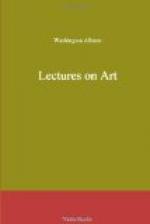To these mixed modes may be added another branch, which we shall term the class of Imputed Attributes. In this class are concerned all those natural objects with which we connect (not by individual association, but by a general law of the mind) certain moral or intellectual attributes; which are not, indeed, supposed to exist in the objects themselves, but which, by some unknown affinity, they awaken or occasion in us, and which we, in our turn, impute to them. However this be, there are multitudes of objects in the inanimate world, which we cannot contemplate without associating with them many of the characteristics which we ascribe to the human being; and the ideas so awakened we involuntarily express by the ascription of such significant epithets as stately, majestic, grand, and so on. It is so with us, when we call some tall forest stately, or qualify as majestic some broad and slowly-winding river, or some vast, yet unbroken waterfall, or some solitary, gigantic pine, seeming to disdain the earth, and to hold of right its eternal communion with air; or when to the smooth and far-reaching expanse of our inland waters, with their bordering and receding mountains, as they seem to march from the shores, in the pomp of their dark draperies of wood and mist, we apply the terms grand and magnificent: and so onward to an endless succession of objects, imputing, as it were, our own nature, and lending our sympathies, till the headlong rush of some mighty cataract suddenly thunders upon us. But how is it then? In the twinkling of an eye, the outflowing sympathies ebb back upon the heart; the whole mind seems severed from earth, and the awful feeling to suspend the breath;—there is nothing human to which we can liken it. And here begins another kind of emotion, which we call Sublime.
We are not aware that this particular class of objects has hitherto been noticed, at least as holding a distinct position. And, if we may be allowed to supply the omission, we should assign to it the intermediate place between the Beautiful and the Sublime. Indeed, there seems to be no other station so peculiarly proper; inasmuch as they would thus form, in a consecutive series, a regular ascent from the sensible material to the invisible spiritual: hence naturally uniting into one harmonious whole every possible emotion of our higher nature.
In the preceding discussion, we have considered the outward world only in its immediate relation to Man, and the Human Being as the predetermined centre to which it was designed to converge. As the subject, however, of what are called the sublime emotions, he holds a different position; for the centre here is not himself, nor, indeed, can he approach it within conceivable distance: yet still he is drawn to it, though baffled for ever. Now the question is, Where, and in what bias, is this mysterious attraction? It must needs be in something having a clear affinity with us, or we could not feel it. But the attraction




